
- TOP 10 Diseases & Conditions Part 1 of 10: Heart Matters. 1 in 3 (633,842)
- TOP 10 Diseases & Conditions Part 2 of 10: Cancer Wars. 1 in 3 (595,930)
- TOP 10 Diseases & Conditions Part 3 of 10: You Take My Breath Away (155,041)
- TOP 10 Diseases & Conditions Part 4 of 10: Accidents Happen unintentional injuries; 5.2% (146,571)
- TOP 10 Diseases & Conditions Part 5 of 10: Stroke (cerebrovascular diseases) 1 in 6 (140,323)
- TOP 10 Diseases & Conditions Part 6 of 10: Alzheimer’s disease 1 in 10 (110,561)
- TOP 10 Diseases & Conditions Part 7 of 10: Diabetes 1 in 4 (79,535)
- TOP 10 Diseases & Condition Part 8a of 10: Influenza (part one) 1 in 10 (57,062) 8b of 10 Pneumonia “The Winter Fever” (part one)
- TOP 10 Diseases & Condition Part 9 of 10: Kidney Disease 1 in 7 (57,062)
There are certainly many more conditions that need attention, but this finishes the TOP 10 Diseases & Conditions Series. I hope to do a summary report next time to end this series. Be sure to stick around for the next series. I am sure you won’t be disappointed.
Intentional self-harm (suicide): 844,193
Additional Facts About Suicide in the US
 According to the World Health Organization, roughly one every 40 seconds or so someone takes their own life in suicide.
According to the World Health Organization, roughly one every 40 seconds or so someone takes their own life in suicide.- For every person who takes their own life, 20 more attempt it.
- The annual age-adjusted suicide rate is 13.42 per 100,000 individuals.
- Men die by suicide 3.53x more often than women.
- On average, there are 123 suicides per day.
- White males accounted for 7 of 10 suicides in 2016.
- Firearms account for 51% of all suicides in 2016.
- Males take their lives four times the rate more than females and represent 77.9% of all suicides.
 The rate of suicide is highest in middle age — white men in particular.
The rate of suicide is highest in middle age — white men in particular.- Females are most likely to have suicidal thoughts.
- 34.8% Poisoning is the most common method of suicide for females.
- 56.9% Firearms are the most commonly used form of suicide in males.
- Officially, over 160,000 people under the age of 25 will kill themselves this year—that’s over 50 times more than died in the September 11 terrorist attacks (unofficially, that’s described as a “gross underestimate”). There’s a killer in our midst, stalking the youngest and most vulnerable. A new black death.
- Every 40 seconds a person dies by suicide somewhere in the world.
- Over 800 000 people die by suicide every year.
 Suicide is an extremely complex issue, and while it is not possible to pin down its causes, there are some risk factors that have been identified, mainly through correlations. Mental health, specifically depression, is widely recognized as the most important risk factor.
Suicide is an extremely complex issue, and while it is not possible to pin down its causes, there are some risk factors that have been identified, mainly through correlations. Mental health, specifically depression, is widely recognized as the most important risk factor.
Suicide is more common in older people: in most parts of the world, the over 70s (particularly the widowed and divorced) are most likely to kill themselves.
Suicide rates are increasing, with suicide accounting for nearly 45,000 deaths in the United States in 2016; 25 percent more than in 2000, according to the National Center for Health Statistics. High-risk groups include: adolescents and young adults at highest risk, American Indians, and Alaska Natives across all ages.
18 or older 2.9% among blacks, 3.3% among Asians, 3.6% among Hispanics, 4.1% among Whites, 4.6% among Native Hawaiians/other Pacific Islanders, 4.8% among American Indian/Alaska Natives, 7.9% among adults reporting two or more races.
Most of those people will say they’d never seriously consider actually trying to harm themselves. Tragically, however, there’s a large percentage of people around the world who think differently. Self-harm types of behaviors directed toward oneself include cutting, burning, hitting, hair pulling, and other acts of intentional self-injury.
I hope to shed light on a dark subject with information that brings hope when there seems to be no hope. Take a small journey with me as we take a look at positive answers that shed light on possible interventions to prevent suicide because all life is valuable, and best news of all,…
Suicides are preventable!
We only have one life to live. Your best life CAN be now.
Topic Lineup:
- Suicide: Related Medical Conditions
- Understanding Depression/Suicide
- The Mystery of the Human Brain
- Stress-Related Factors
- Depression Linked to Nutrient Deficiencies
- Other nutrients for brain health: Probiotics
- Anti-Depression Diet
Suicide: Related Medical Conditions
 Depression
Depression- Bipolar disorder
- Antidepressants
- Schizophrenia
- Personality disorder
- Schizophrenia form disorder
- Post traumatic disorder
Understanding Depression/Suicide
What could cause suicide (self-destruction)?
1. Biological
- Some mental illnesses have been linked to abnormal balance of special chemicals in the brain called neurotransmitters. Neurotransmitters help nerve cells in the brain communicate with each other. If these chemicals are out of balance or are not working properly, messages may not make it through the brain correctly, leading to symptoms of mental illness.
- Poor nutrition and exposure to toxins, such as lead, may play a role in the development of mental illnesses.
2. Psychological factors that may contribute to mental illness include:
- Severe psychological trauma suffered as a child, such as emotional, physical, or sexual abuse
- Coping with past or current traumatic experiences such as abuse, bereavement or divorce will strongly influence an individual’s mental and emotional state which can in turn have an influence on mental health
- An important early loss, such as the loss of a parent
- Neglect
- Poor ability to relate to others
3. Certain stressors can trigger an illness in a person who is susceptible to mental illness. These stressors include:
- A dysfunctional family life
- Living in poverty
- Significant life changes
- Social or cultural expectations
- overwhelmingly painful emotions, perhaps of deep sadness, intense fear, rage or self-loathing.
You have the ideal recipe for happiness inside you.
I can hardly wait for you to read further. Your body has the amazing ability to make “happy chemicals” naturally – no drugs, no side effects, no danger of addiction – that will leave you feeling better than you might believe possible. You have access to these feel good compounds today.
The Mystery of the Human Brain
All of us are born with a factory just waiting to manufacture feelings of happiness – bliss even – yet we’ve forgotten how to turn on the machines. Brain chemistry is a field researched all over the world. Your brain is capable of so much that scientists can search for years to discover the answer to one small aspect of how it works. It is only recently that they began to understand that the dance of neurotransmitters and hormones inside your body determine the bulk of your moods and personal satisfaction.
The Hippocampus is involved in the emotional, mood, depression, Post-Traumatic Syndrome (PTS), and bipolar disorders. A small hippocampus generally shows the symptoms of these disorders. It’s structure is effected positively or negatively by our thoughts and actions. Imagine that for a minute! If we can control our thoughts and actions, we are better able to control our environment. Our conscience is formed by our choices; and, our senses of sight, touch, taste, smell, and hearing are all inputs.
Reprogram your subconscience through repetition – Habits that change emotions. Emotions are chemicals.
 The brain is very elastic and constantly receiving communication:
The brain is very elastic and constantly receiving communication:
~~~~~
Consistent firing = Consistent Chemical Production = Constant Emotions
~~~~~
Learning = Repetition = Reprogramming
~~~~~
Both our conscious and unconscious minds lead to our body’s response.

Memorizing the scriptures with promises that bring hope that will restore your mind.
Philippians 4:8 Finally, brethren, whatsoever things are true, whatsoever things are honest, whatsoever things are just, whatsoever things are pure, whatsoever things are lovely, whatsoever things are of good report; if there be any virtue, and if there be any praise, think on these things.
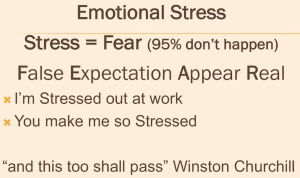 Stress-Related Factors
Stress-Related Factors
STRESS – physical, chemical, emotional stresses the source of mental illness your body doesn’t know the difference. You will be in constant fight or flight state.
Stress is something everyone in modern society seems to understand. There are two basic kinds of stress: inner stress from previous traumas or wounds that affect one’s present life; and outer stress, or the environmental issues that complicate life on a daily basis, such as work or family problems.
The interplay of these two forms of stress affects brain chemistry just as it can affect physical health. Numerous studies have shown that when people are chronically stressed in life, they are vulnerable to depression, anxiety, and other disorders. What can be done to reduce the stresses in our lives?
Tip 1: Confide in someone
 The first step is to confide in another person. It can be scary to talk about the very thing you have worked so hard to hide, but it can also be a huge relief to finally let go of your secret and share what you’re going through. Deciding whom you can trust with such personal information can be difficult. Choose someone who isn’t going to gossip or try to take control of your recovery. Ask yourself who in your life makes you feel accepted and supported. We are encouraged to bear one another’s burdens.
The first step is to confide in another person. It can be scary to talk about the very thing you have worked so hard to hide, but it can also be a huge relief to finally let go of your secret and share what you’re going through. Deciding whom you can trust with such personal information can be difficult. Choose someone who isn’t going to gossip or try to take control of your recovery. Ask yourself who in your life makes you feel accepted and supported. We are encouraged to bear one another’s burdens.
Galatians 6:2 Bear ye one another’s burdens, and so fulfil the law of Christ.
In the world of psychiatry, they use the term “talk therapy”. There are many different kinds of talk therapy. The two most commonly used for depression are cognitive-behavioral therapy (CBT) and interpersonal therapy. CBT focuses on looking at how negative thought patterns may be affecting your mood. The therapist helps you learn how to make positive changes in your thoughts and behaviors. While this type of therapy may be helpful at times, it doesn’t have answers that target the deep areas of hurt. There is a counselor that does and His name is Jesus. Isaiah 9:6 tells us He is the … counselor …. He consults, guides, and gives purpose and hope through His Word like no man can.
1 Peter 5:7 Casting all your care upon him; for he careth for you.
Tip 2: Identifying triggers
Understanding what triggers to cut or self-harm is a vital step towards recovery. Self-harm is most often a way of dealing with emotional pain. What feelings make someone want to cut or hurt themselves? Sadness? Anxiety? Anger? Loneliness? Shame? Emptiness?
No matter how lonely, worthless, or trapped a person may be feeling at the moment, there are many other, more effective ways to overcome the underlying issues that drive self-harm.
Tip 3: Release tension or vent anger through exercise.
Tip 4: Listen to calming music
Tip 5: Start a journal to express feelings.
TIP 6: Helping a someone who cuts or self-harms
TIP 7: Learn about the problem.
TIP 8: Don’t judge. Avoid judgmental comments and criticism—they’ll only make things worse. Remember, the self-harming person already feels distressed, ashamed and alone. Be sympathetic.
TIP 9: Offer support, not ultimatums.
TIP 10: Encourage communication. Encourage your loved one to express whatever they’re feeling, even if it’s something you might be uncomfortable with.
- Matthew 10:31 – Fear ye not therefore, ye are of more value than many sparrows.
- Psalm 118:5-6 5 I called upon the LORD in distress: the LORD answered me, and set me in a large place.
- The Lord is on my side; I will not fear: what can man do unto me?
- Psalm 94:19 In the multitude of my thoughts within me thy comforts delight my soul.
Depression Linked to Nutrient Deficiencies
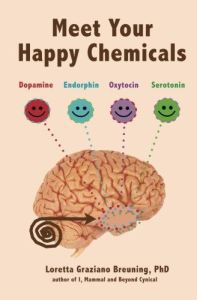 Over the past few decades, we’ve gradually shut down the production of the substances Melatonin, Anandamide, Dopamine, Serotonin, Endorphins, with our diet and lifestyle choices. The result has been a dramatic increase in depression, eating disorders, suicide rates, substance abuse, and general unhappiness that affects every part of your daily life.
Over the past few decades, we’ve gradually shut down the production of the substances Melatonin, Anandamide, Dopamine, Serotonin, Endorphins, with our diet and lifestyle choices. The result has been a dramatic increase in depression, eating disorders, suicide rates, substance abuse, and general unhappiness that affects every part of your daily life.
The pharmaceutical industry responded to these issues with dozens of “feel good drugs” that come weighted with dangerous side effects and the possibility of addiction.
First Resort and/or Last Resort – Test to make sure these drugs are absolutely necessary. Medication may be needed when your depression is severe, self-harm has happened, or you begin feeling suicidal thoughts. Natural cures do not work fast enough or strong enough to bring quick change that is needed to preserve life. Once people start feeling better, they should seek out treatments for depression without medication. That way the body can begin to take over regulating its own hormones and you do not need to rely on the prescription medication.
Prescription medication, otherwise known as drugs, have dangerous antidepressant side effects. Freedom of Information Act (FIA) has exposed these medications that can cause brain shrinkage, cause the “blunt effect” a condition of reduced emotional reactivity in an individual. It manifests as a failure to express feelings. This is also a part of Frontal Lobe Syndrome (FLS).

One of the side effects of medication for depression is weight gain. During the depression, the hormones that regulate hunger and fullness are disrupted. As your hormones become regulated, you will begin to feel hungry again. The biggest reason for weight gain is that you become hungry for foods that lack nutritional value and are high in sugars. These appetite changes are stoppable. Normally, serotonin, acting on certain receptors on brain cells, produces a sense of satiation or fullness. If you can control yourself, which is very difficult coming out of depression, choose healthy fruits and vegetables. This will help prevent any weight gain and give your body the nutrition to fight the depression.
No drug has ever gotten rid of the problem. It only covers the symptom like a bandage and it always has side effects.
Melatonin
Your pineal gland produces a hormone called melatonin. It is responsible for quality sleep – something the majority of Americans do not get – as well as adjusting to new sleep cycles (such as changing your work schedule), jet lag, and chronic fatigue. When darkness falls, your body produces more melatonin to get you ready to sleep.
Foods such as Bing Cherries, Walnut (tryptophan for sleeping), pineapples (B vitamins), bananas (tryptophan converts to melatonin), oranges, and tomatoes help to boost your body’s natural production of melatonin. Leafy greens contain calcium which helps the brain use tryptophan to make melatonin). Better sleep quality means better mood, more energy, and a happier you!
Green Juice is very healing. Drink when you rise, before you go to bed, and 30 minutes before meals.
Anandamide
It’s been called the “bliss molecule,” aptly named after ananda, the Sanskrit word for “joy, bliss, or happiness.” The neurotransmitter anandamide is responsible for easing pain in the body, improving mood, and boosting brain function. It is a fragile compound Located in the higher thought areas of your brain. By increasing neurogenesis — the formation of new nerve cells — anandamide exhibits both anti-anxiety and antidepressant properties. Anandamide, like all neurotransmitters, is fragile and breaks down quickly.
Chocolate is one of the most beloved foods on the planet. It’s rare to meet anyone who doesn’t enjoy chocolate. It’s known for sure that chocolate contains mood-boosting caffeine and phenylethylamine, a substance called the “love molecule” that simulates the feeling of being in love. It also contains theobromine, a substance related to caffeine, that acts as a relaxant rather than a stimulant. It’s thought that theobromine causes the brain to produce more anandamide. more of a neurotransmitter, anandamide, account for the euphoric sensation. Chocolate contains compounds that slow anandamide’s breakdown.
Dopamine
The neurotransmitter dopamine is well-known as a happy chemical released by your nerve cells and sends signals to other nerve cells and a precursor of other substances including epinephrine (another term for adrenaline). Its biggest job is controlling the pleasure and reward centers of your brain. Believe it or not it also plays a big role in maintaining a healthy weight. When you have adequate levels of dopamine in your system you eat less, make wiser choices, and are more focused. Dopamine motivates us to take action toward goals, desires, and needs, and gives a surge of reinforcing pleasure when achieving them.
Foods like almonds and walnuts, sesame seeds, sunflower seeds and pumpkin seeds. All contain l-phenylalanine which convert into tyrosine which then converts into dopamine. Bananas, apples, beets
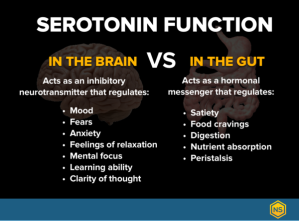 Serotonin – the brain in your head “The feel good hormone”
Serotonin – the brain in your head “The feel good hormone”
When you feel significant or important you have good serotonin levels. Serotonin is a compound present in blood platelets and serum that constricts the blood vessels and acts as a neurotransmitter. It may come as a surprise to learn that the majority of the feel good neurotransmitter serotonin is manufactured and resides in your gut. This compound is responsible for mood, appetite, quality of sleep, feelings of sexual desire, and high-level brain function such as memory and learning. Works good with dopamine.
Serotonin and norepinephrine are most highly implicated in depression, panic disorder and anxiety, as well as OCD.
Protein prevents an amino acid tryptophan from getting into the brain (even though protein contains tryptophan) and making new serotonin.
Food like almonds, walnut, cashews, help formation of serotonin. Eat a handful of nuts a day. Flaxseeds or flaxseed oil helps maintain serotonin. Banana’s have tryptophan that helps with formation. Dark chocolate is high in serotonin. pineapples contain high levels of serotonin. Always use fresh not canned.
Expose yourself to the sun for 20 minutes; our skin absorbs UV rays, which promotes vitamin D and serotonin production.
Endorphins
The hormones known as endorphins are produced in the pituitary gland and central nervous system and are also considered neurotransmitters. They are in charge of many functions that relate to overall feelings of happiness and wellbeing. These hormones are your body’s first line of defense against pain called peptides, provide an opiate effect (similar to morphine causing an analgesic effect (relieve pain) after exercise or trauma, and basically make you feel pretty fantastic. They can be stimulated by foods such as cacao (dark chocolate) boost endorphins naturally, and nuts. Exercise is usually attributed to endorphins known as “Runners high”.
Oxytocin
Oxytocin creates intimacy, trust, and builds healthy relationships. Often referred to as the cuddle hormone, a simple way to keep oxytocin flowing is to give someone a hug. When someone receives a gift, their oxytocin levels can rise.
Other nutrients for brain health:
MUSIC: Regulate your mood with the help of music. Music can help people cope with physical pain.
EXERCISE: is also crucial to preventing weight gain. Your physician may not mention it so it is up to you to find a way to move.
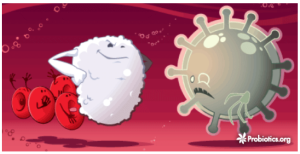 Eliminate depression from your life with the help of probiotics!
Eliminate depression from your life with the help of probiotics!
Both the University of Virginia School of Medicine and McMaster University have found that consuming the friendly bacteria causes a natural antidepressant effect. The environment of the gut seems to be in direct communication with the brain. Probiotics offer a non-toxic way of overcoming the unwanted consequences of depression.
In a study published in the medical journal Gastroenterology, researchers of the Farncombe Family Digestive Health Research Institute found that consumption of a specific probiotic can improve both gut symptoms and psychological issues in IBS. IBS is the most common gastrointestinal disorder in the world. It affects the large intestine and patients suffer from abdominal pain and altered bowel habits like diarrhea and constipation. They are also frequently affected by chronic anxiety or depression. Signals generated by the brain can influence the composition of microbes residing in the intestine and that the chemicals in the gut can shape the human brain’s structure.
A study out of McMaster University Farncombe Family Digestive Health Research Institute linked probiotics and improvement in symptoms of depression as well as gastrointestinal upset.
The research looked at adults with irritable bowel syndrome (IBS) and found they reported improvements from both their gastrointestinal issues and depression from a specific probiotic versus those taking a placebo.
1. Lactobacillus bacteria (in particular) was found to reverse depressive behavior in mice. The researchers determined that it did so by altering their gut microbiome – which refers to the population of friendly microorganisms in the intestines.
Stress seems to lead to the loss of Lactobacillus in the gut – which in turn paves the way for the symptoms of depression. Lactobacillus levels in the gut microbiome also influence kynurenine (made in many tissues in response to immune activation) levels, a blood metabolite associated with the onset of depression and suicide. Low levels of Lactobacillus bacteria should be avoided to preserve emotional wellbeing
2. Bifidobacterium longum NCC3001 eases symptoms of IBS and depression
10 week Study – 44 adults with mild to moderate anxiety or depression and IBS were followed. After six weeks, 64 percent of those taking the probiotic showed reduced depression markers. It can also reduce anxiety.
Researchers have even figured out that it works by acting through the vagus nerve. The vagus nerve is the longest cranial nerve in your body.
It connects your brain to many important organs throughout the body, including the gut (intestines, stomach), heart and lungs.
In fact, the word “vagus” means “wanderer” in Latin, which accurately represents how the nerve wanders all over the body and reaches various organs.
There are exactly 653 high quality probiotics products available for sale. You probably don’t have time to research all 653, so Probiotics.org did all that work for you. These articles came from the very best minds at Harvard, Yale, University of Japan & 32 other universities. You should fill out the form & find your perfect probiotic 🙂 Probiotics
3. Bifidobacterium longum (strain R0175) Researchers have concluded that this strain can reduce cortisol and alleviate psychological distress in humans (including obsessions, compulsions, paranoia, anxiety)
4. Lactobacillus rhamnosus (strain GG) Can lower anxiety in humans. GABA is the main inhibitory and relaxing neurotransmitter in the central nervous system, and studies suggest that lactobacillus rhamnosus (strain JB-1) may reduce anxiety by changing the expression of GABA receptors.
Has also been shown to reduce obsessive-compulsive disorder (OCD)-like behaviour in mice. In fact, researchers found it was just as effective as fluoxetine, an SSRI antidepressant commonly used to treat OCD
5. Lactobacillus plantarum (strains CECT7484 and CECT7485) to patients with irritable bowel syndrome and it significantly reduced their anxiety and improved their quality of life.
6. Lactobacillus plantarum (strain PS128) can cause positive changes in emotional behaviours and significantly reduce anxiety-like behaviours. It does this by increasing dopamine and serotonin, lowering stress hormone levels, and reducing inflammation. It has psychotropic properties without physical side effects, and has great potential for treating neuropsychiatric disorders, including anxiety.
Lactobacillus plantarum is also commonly found in many fermented vegetables including sauerkraut, pickles, brined olives, kimchi.
7. Lactobacillus helveticus (R0052) is a probiotic strain that has been shown to reduce cortisol and have anti-anxiety effects in humans. It can even reduce paranoid and obsessive-compulsive thoughts.
Animal research shows that a Western-style diet can negatively change the gut microbiome, increase brain inflammation, and contribute to anxiety. But lactobacillus helveticus (strains ROO52 and NS8) can protect against this, reducing both neuroinflammation and anxiety. Lactobacillus helveticus (strain NS8) works better than citalopram, a common SSRI antidepressant, at reducing anxiety-like behaviour in rats. It also reduced their stress hormone levels and increased their serotonin levels
8. Lactobacillus reuteri (strain 23272) can reduce anxiety-like behaviours in animals by reducing stress hormone levels and altering the expression of GABA receptors
9. Lactobacillus fermentum is another species that is part of the human microbiome and commonly found in fermented vegetables. But there still is some evidence that is may be able to help treat anxiety, especially if you have a long history of antibiotic treatment.
Typically, it is recommended that people try one probiotic strain at a time to figure out how they respond to each one. You can click here to find the perfect probiotic for your symptoms.

The role diet plays in mood as well as overall physical health. Research from 2014 linked friendly gut bacteria with reduced stress and anxiety in human adults.
Berries: The National Institute of Health (NIH) conducted a study that found compounds in berries – blueberries, strawberries, blackberries, raspberries and cranberries that block chemicals in our brain that depression and anxiety.
Papayas (reduce stress): Studies have found out that this fruit contains powerful compounds that help to create a chemical in our body that decreases pain and gives us a sense of calm and well-being. Folic Acid and Vitamin B6 to Remove Homocysteine play an important part in stress management. Folic acid also acts on your hypothalamus to aid in the production of an anti-stress hormone.
Radish: Research has found that every different kind of radish has compounds that increase chemicals in our brain that produce a better mood such as dopamine and norepinephrine.
Avocado: Studies have discovered two compounds in avocado that play a key role in fighting depression – tryptophan and omega-3 fatty acid.
Collard Greens: Collard greens are high in magnesium which powerfully assists in fighting depression by producing serotonin.
Mango: This tropical fruit is rich in B-6 which promotes the production of serotonin, a powerful and natural mood-lifting compound in the brain.
Citrus: All citrus fruit is rich in vitamin C and folate which increase the production of dopamine and have an antidepressant effect.
Anti-Depression Diet – eat to change the mood (food drives mood) Colorful foods like the rainbow brighten your day. Eat more of them.
NUTRITIONAL FACTORS. There is no doubt that poor nutrition leads to mental imbalances. While few people in the United States are truly starving or completely depleted nutritionally, instances of mental disorders related to malnutrition still occur in this country. In fact the U.S. is well fed but malnourished. The statistics prove it!
All natural foods contained antidepressant qualities. None of them act as antidepressants, but every single fruit and vegetable will contribute to keeping you happy and healthy. The foods that help the most with depression are the ones that you may not seek out. They are going to be the ones that are darker in color, a little bit more bitter in taste, and low in carbohydrates. In other words, any fruit or vegetable but not potatoes.
Here are a couple of recipes that should be uplifting:
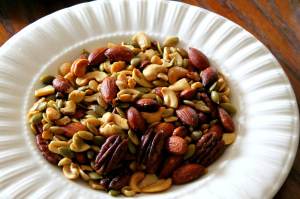 Savory Roasted Nut
Savory Roasted Nut
- 1 tsp Garlic powder
- 2 tbsp Avocado oil
- 1/2 tsp Himalayan Pink Sea Salt (HPSS)
- 1 cup Almonds
- 1 cup Cashews
- 1 tsp Cumin
- 1 cup Pecans
- 1/2 cup Pumpkin seeds
- 2 tsp liquid smoke
Soak all nuts for at least 12 hours. Rinse well. Put all ingredients in a bowl and stir. Put in oven and roast.

Hot Chocolate Breakfast Smoothie
- 2 cup Blueberries
- 1/2 Orange
- 1 Mango
- 1 Avacado
- dash of Turmeric
- dash or Match Green Tea
Thank you so much for taking the time to stop by. It shows your interest in health. If you enjoyed this post, please press the follow button, like it, and share how it helped you. If you know someone who could be helped by this information please pass it on. People are destroyed from a lack of knowledge. Hosea 4:6. I’d be very grateful if you’d help it spread the word so that more people can live their best life now free and to the fullest.



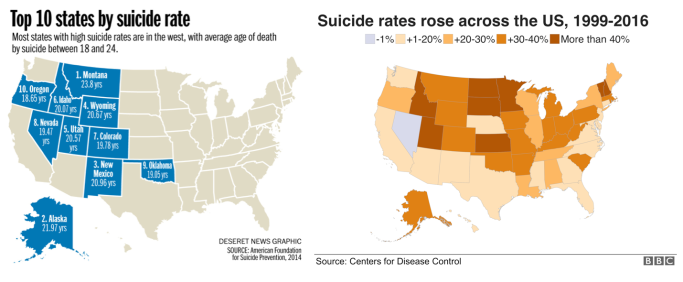

One thought on “Top 10 Diseases & Conditions Part 10 of 10: Depression * Suicide * Self-Harm (Supercharge Your Happy Chemicals)”